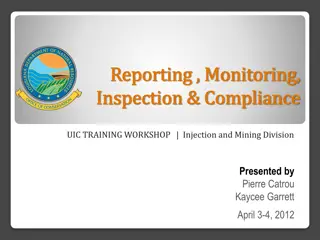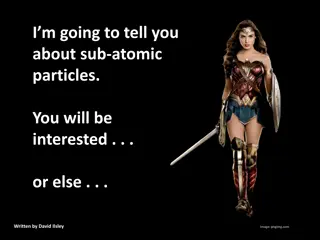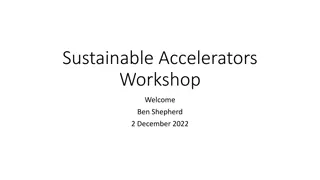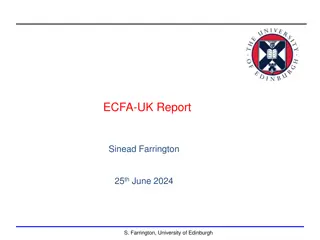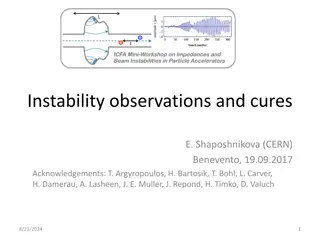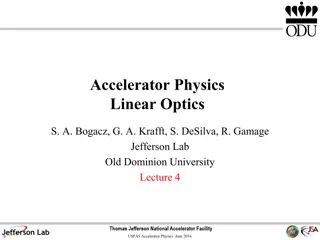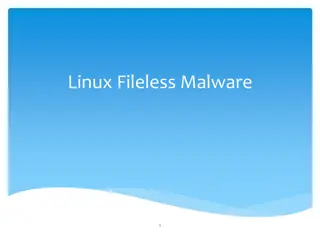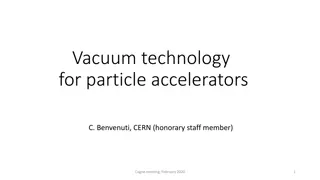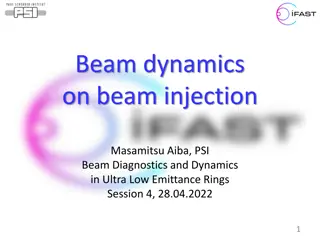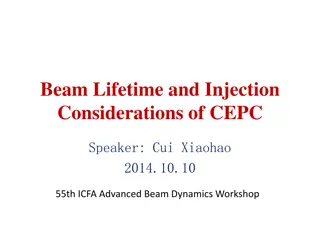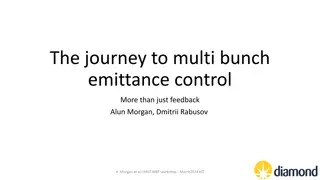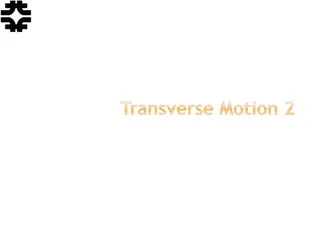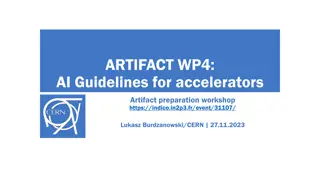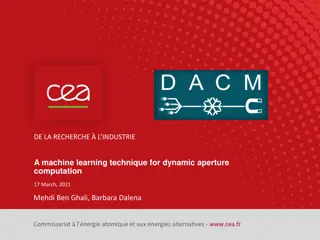Injection Process in Particle Accelerators
The injection process in particle accelerators involves transferring beams efficiently with minimal loss and emittance dilution. It includes on-axis injection onto the reference orbit using septum magnets and fast kickers to maintain beam trajectory accuracy. The design aims to achieve precise beam transfer between accelerators. Fast kicker magnets are essential components that require precise timing for beam deflection. The process is crucial for transitioning beams between linear and circular accelerators.
Download Presentation

Please find below an Image/Link to download the presentation.
The content on the website is provided AS IS for your information and personal use only. It may not be sold, licensed, or shared on other websites without obtaining consent from the author.If you encounter any issues during the download, it is possible that the publisher has removed the file from their server.
You are allowed to download the files provided on this website for personal or commercial use, subject to the condition that they are used lawfully. All files are the property of their respective owners.
The content on the website is provided AS IS for your information and personal use only. It may not be sold, licensed, or shared on other websites without obtaining consent from the author.
E N D
Presentation Transcript
Storage Ring Injection S. Guiducci LNF, 22 July 2016
Outline On axis injection Extraction Off axis injection for electrons or positrons
Injection Injection covers the final stage of transfer of beam from one accelerator to another, either from a linear to a circular machine or from one circular machine to another The design aims are to achieve the transfer with little beam loss and with a minimum dilution of the beam emittances
On axis injection Beam is injected onto the reference orbit via a septum magnet and a fast kicker element, with appropriate matching arranged in the transverse and longitudinal planes For efficient injection there should be no beam loss and very little emittance dilution, only that associated with transfer errors
On axis injection x, y septum xs s kicker The septum magnet gives a deviation to the incoming bunch without affecting the beam on the reference trajectory When the incoming beam trajectory crosses the axis a fast pulsed kicker deflects the beam and puts it on the reference trajectory When the bunch cross the kicker again after 1 turn the kicker is off
Septum magnet Fascio iniettato Stored beam Field free region Uniform field From transfer line Incoming beam Uniform field Field free region Stored beam
kicker Fast kicker magnets require to be switched off in times typically of 50 to 150 ns The kickers are powered from pulse-forming networks which are charged in the off-time of the machine cycle and rapidly discharged via thyratron switches when needed. The rise and fall times of the pulse are functions of the thyratron characteristics and the kicker design For very short pulse duration solid state devices are used Times of a few ns have been achieved in various tests (~ 5 ns at DA NE) and are required for future machines (damping rings for the International Linear Collider and very low emittance synchrotron light source storage rings)
On axis injection x, y septum xs s In this example we assume x = 0 and Dx = Dx = 0 at the septum Orbit at septum: x = xs, x s = 0 The orbit at the kicker is: With sk the phase advance between septum and kicker. To have x=0 at the kickera phase advance sk = 90 is required ( =kicker angle): x'k=q = xk=0 xs bsbk
On axis injection Successful on axis injection requires that: the stray field of the septum unit is at an acceptable level the kicker field is reduced to zero in a time less than a fraction of the revolution period the RF system is capable of containing the transient beam loading introduced at the instant of injection
Beam matching in the transverse plane (x, x or y, y) At the septum exit the betatron and dispersion functions x, x, y, y, Dx, D x, Dy, D y must be identical to the ring lattice parameters at that point Courant-Snyder ring invariant x septum x 0 0 x x Injected beam ellipse xs After the kicker inj = stored At septum exit: injected beam is matched emittance is preserved
Beam matching in the transverse plane (x, x or y, y) At the septum exit the betatron and dispersion functions x, x, y, y, Dx, D x, Dy, D y must be identical to the ring lattice parameters at that point For simplicity we assume: x = 0 and x = 1/ x After the kicker Courant-Snyder ring invariant x septum Injected beam ellipse x 0 0 x x inj < stored xs max= einjbinj ( max= einj/binj x'inj xinj At septum exit inj < stored emittance increases as stored/ inj ) 2bstored=einjbstored/binj estored= x'inj max
Beam matching in the transverse plane (x, x or y, y) At the septum exit the betatron and dispersion functions x, x, y, y, Dx, D x, Dy, D y must be identical to the ring lattice parameters at that point For simplicity we assume: x = 0 and x = 1/ x After the kicker Courant-Snyder ring invariant x septum Injected beam ellipse x 0 0 x x inj < stored xs max= einjbinj ( ( max= einj/binj x'inj xinj At septum exit inj < stored emittance increases as: stored/ inj ) 2bstored=einjbstored/binj estored= x'inj max ) 2/bstored=einjbinj/bstored) (for inj > stored emittance increases as: inj / stored ) or ( estored= xinj max
Extraction x, y septum xs s Extraction is the inverse of the injection process The kicker is turned on just before the bunch passage and deflects the beam out of the septum The orbit after the kicker is: xk=0 The orbit at the septum is : With ks the phase advance between kicker and septum To have x =0 at the septuma phase advance ks = 90 is required:
Off axis injection To increase the current with respect to what is provided from the injector we want to inject the bunch on top of an already stored bunch In this case the kicker used to deflect the incoming bunch on the central trajectory deflects the already stored bunch out of the storage ring aperture To keep the stored bunch inside the aperture the kicker amplitude must be reduced The injected beam will be placed inside the ring aperture with a residual oscillation amplitude respect to the central orbit The residual oscillation amplitude will be reduced due to radiation damping and will become negligible in a few damping times This is the most common injection procedure for electrons and positrons
Off axis injection The stored bunch orbit is displaced towards the septum by means of 2 kickers with phase advance difference in between The first kicker k1deflects only the stored bunch The second kicker k2 kicks both the stored and the injected beam The stored beam is put back on the central orbit The injected beam is put inside the aperture with a residual oscillation orbit k1 k2
Off axis injection s Injection orbit septum stored beam on injection orbit xst stored beam on central orbit injected beam 4 xstored Ax xinjmax Minimal aperture needed at septum Ax: Axhas to be large enough to assure good beam lifetime for the stored beam Ax> xinjmaxfor good injection efficiency
Off axis injection s Injection orbit septum stored beam on injection orbit xst stored beam on central orbit injected beam 4 xstored Ax xinjmax To keep losses on stored beam below 0.13% (probability for a gaussian distribution to be outside 3 ) ) we take n=3 To injected 99% of the incoming beam we take k=2
Off axis injection s Injection orbit septum stored beam on injection orbit xst stored beam on central orbit injected beam 4 xstored Ax xinjmax The angle of the injection kicker is: The maximum oscillation amplitude of the injected beam after the kicker is: And the corresponding phase space ellipse is:
Off axis injection issues Needed aperture Optimum beta matching inj < stored High value of beta stored at septum reduces the impact of the septum thickness Beam losses Losses on the stored beam depend on the distance of the bumped orbit from the septum Losses on injected beam depend on the distance from septum and on the maximum oscillation amplitude included in the ring aperture Nonlinear elements in the ring and instabilities can produce losses of the injected beam Losses due to errors and jitters: orbit, energy, matching, beam size
Off axis injection issues Kickers synchronization It is very important that the orbit bump produced by the 2 kickers is very well closed to avoid oscillations of the stored beam: correct amplitude, good time synchronization and correct phase advance Injection saturation When the particles lost in the injection pulse are equal to the particles in the incoming bunch the injection saturates and the current in the ring cannot be further increased
Multi-turn injection For protons or heavy ions, if the injected beam is longer than one revolution period, a multi-turn injection is used The orbit bump is reduced with time so that the early beam occupies the central region of the horizontal acceptance and the later beam the periphery of the acceptance At the end of injection the beam bump is reduced to zero Because of the finite thickness of the septum and the elliptical phase-space contours of the injected beam, there must result some emittance dilution If the injector emittance is i and the number of injected turns is n the resulting emittance in the ring is: st > 1.5n i
MultiTurn Injection In progress ~15 turns ~30 s bump ~10 mrad kicks 5.00E-03 Efficiency vs NTURNS 4.00E-03 3.00E-03 1.825 2.00E-03 1.8 1.00E-03 1.775 0.00E+00 -4.00E-02 -3.00E-02 -2.00E-02 -1.00E-02 0.00E+00 1.00E-02 2.00E-02 3.00E-02 -1.00E-03 1.75 -2.00E-03 1.725 -3.00E-03 -4.00E-03 10 12 14 16 18 20 22 24 -5.00E-03



